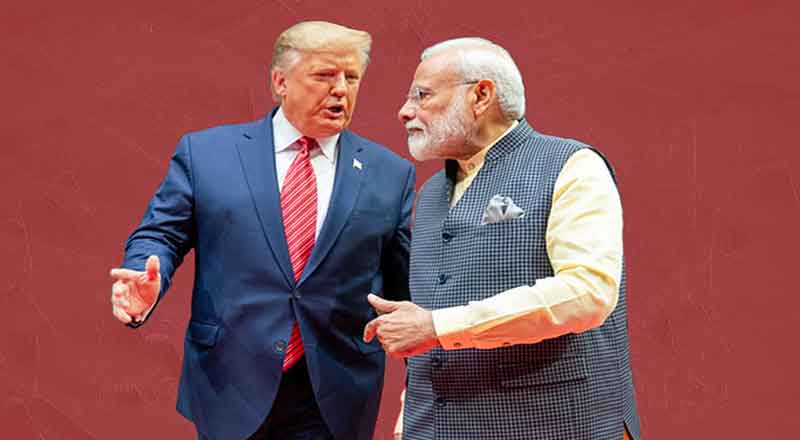As the prospect of Donald Trump returning to the White House in 2025 looms, India is closely examining how a second Trump administration might reshape the India-US relationship. In his campaign, Trump has reiterated his “America First” vision, signaling a foreign policy direction that may prioritize U.S. interests more aggressively, perhaps even at the cost of long-standing alliances. India, a strategic U.S. partner, has much at stake, with potential implications spanning trade, immigration, military cooperation, and global diplomacy.
Indian Foreign Minister S. Jaishankar recently noted that the U.S. might adopt a more isolationist stance regardless of the election outcome. However, Trump’s past rapport with Prime Minister Narendra Modi, showcased in events like “Howdy Modi!” and “Namaste Trump,” could bring both new opportunities and challenges if Trump were to reassume office. This article explores how a Trump 2.0 presidency could impact key dimensions of India-US relations.
Trade Relations: Reciprocity and Tariff Implications
Trump has often vocalized his dissatisfaction with trade practices that he perceives as unfair to the U.S., and he has criticized countries with high tariffs, including India. Recently, Trump labeled India a “big charger” of tariffs, promising to pursue a “reciprocity” policy that could impose retaliatory tariffs on Indian exports to the U.S. Such measures might affect India’s crucial exports in sectors like pharmaceuticals, textiles, and information technology, which rely heavily on the U.S. market.
Conversely, Trump’s continued effort to decouple economically from China could offer new opportunities for India. As U.S. businesses look to diversify their supply chains, India could position itself as a manufacturing alternative to China, aligning with the Indian government’s “Make in India” initiative. However, any significant tariff hikes by Trump might complicate this opportunity, potentially dampening U.S.-India trade growth.
Immigration Policies and the Indian Workforce
The H-1B visa program, which allows skilled foreign workers—many of whom are Indian—to work in the U.S., has been a focal point of Trump’s immigration policy. During his first term, Trump’s administration attempted to tighten visa requirements, making it harder for Indian tech professionals to secure positions in the U.S. This impacted both Indian workers and American tech firms that rely heavily on skilled Indian talent.
If re-elected, Trump could reinstate or intensify such restrictions, making it challenging for Indian IT professionals to find and retain jobs in the U.S. Such changes could impact India’s economy by limiting the remittances Indian expatriates send home. For India’s tech sector, this would mean a possible talent drain and reduced revenue from U.S.-based projects. That said, stricter immigration policies could also encourage Indian tech talent to seek opportunities in other countries or contribute to India’s growing domestic tech ecosystem.
Military and Defense Cooperation: Strengthening Ties in the Indo-Pacific
India and the U.S. have seen substantial military cooperation, especially in recent years. Initiatives like the Initiative on Critical and Emerging Technology (iCET) and major defense agreements, such as the GE-HAL jet engine deal, underscore a strengthening defense relationship. Under Trump’s first term, defense partnerships, including India’s involvement in the Quad alliance (U.S., India, Japan, and Australia), grew in importance as both countries sought to counter China’s expanding influence in the Indo-Pacific region.
While Trump’s isolationist tendencies have raised questions about his commitment to international military pacts, his past support for the Quad suggests that a second term could continue building on India-U.S. military cooperation. The shared goal of countering China’s military and economic influence is likely to keep defense ties intact, with probable advancements in technology sharing, arms sales, and joint military exercises. Trump’s “Peace through Strength” philosophy could align with India’s goals, especially regarding counterterrorism efforts and securing stability in South Asia.
Diplomatic Relations and Global Alliances
Diplomatically, Trump’s “America First” approach has often led to a recalibration of U.S. alliances. During his first term, he pulled the U.S. out of agreements like the Paris Climate Accord and the Iran nuclear deal, challenging international consensus. Should Trump win again, his administration might withdraw or reconfigure U.S. involvement in multilateral forums, which could impact India’s own global diplomatic strategies.
India, traditionally a proponent of multilateralism, may find itself navigating complex dynamics if a Trump-led U.S. takes a more unilateral stance on global issues. However, Modi’s personal rapport with Trump could serve as a bridge, potentially allowing India to maintain open channels of dialogue even as Trump re-evaluates U.S. international commitments.
Conclusion
A potential second term for Trump presents a mixed picture for India. While challenges in trade and immigration policies could strain certain aspects of the relationship, defense cooperation and mutual goals in the Indo-Pacific region could continue to flourish. The personal camaraderie between Trump and Modi may act as a stabilizing factor, allowing both leaders to find common ground amid shifting priorities. For India, a Trump 2.0 administration could mean navigating a fine line between opportunity and risk, balancing the benefits of closer ties with the challenges of a more insular U.S. foreign policy.
In a rapidly changing global landscape, India’s approach to a second Trump administration will likely be shaped by pragmatism, a commitment to strategic autonomy, and the enduring importance of a strong U.S. partnership.
(With inputs from agencies)





